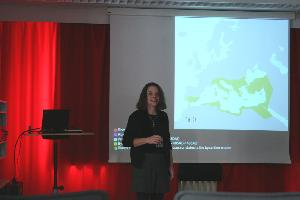 On the afternoon of January 13, in a dark lecture hall with the only rays of light coming from the projector and the slides, the AY students began their journey through the Italian Renaissance, led by Lynn Catterson, a guest lecturer from Columbia University.
On the afternoon of January 13, in a dark lecture hall with the only rays of light coming from the projector and the slides, the AY students began their journey through the Italian Renaissance, led by Lynn Catterson, a guest lecturer from Columbia University.
How is it decided that a certain period of time is to be labeled “the Renaissance”? What is the difference between Medieval and Renaissance art? What triggered the transition in the first place? The answers to these questions were the foundation on which the lecture was built over the course of three hours. Making sculpture as the focus of interest, we saw the transformation from the stiff, covered representation of the human body characteristic of the Medieval Period, to the grace and sensuality of Michelangelo’s David. This work epitomizes the revived interest in antiquity which was directly ‘responsible’ for the emergence of the Renaissance.
Interestingly enough, it is Florence which is considered to be the ‘birthplace’ of the Italian Renaissance, although one would expect that place to be none other than Rome, since the major remains of the Roman Empire are to be found there. A peculiar event that took place in 1401, noted by Giorgio Vasari (considered to be the first art historian) in his work Lives of the Artists, offers a plausible explanation for this. Filippo Brunelleschi (1377-1446), an Italian sculptor, entered a competition, together with seven other contestants, to design a set of bronze doors for the Baptistery of Florence. He lost the contest to Lorenzo Ghiberti. Taking this as an insult, Brunelleschi decided to leave Florence and go to Rome, accompanied by Donatello, who was his contemporary and a highly esteemed sculptor. What they found in Rome was a treasure of monuments from the ancient Roman Empire, which were subject to the sculptors’ close examination. What is more, they excavated “pieces of capitals, columns, cornices, and bases of buildings buried underground”. The people of Rome were not used to this, and they even mistook Brunelleschi and Donatello for “treasure-seekers”. It is through these two artists’ discoveries that the antique penetrated the artistic values of medieval art and shattered the principles on which it was founded.
Having given us a thorough introduction to the events that heralded and conceived the Renaissance, Catterson paved the way for a meticulous examination of Donatello’s life and work, and the immense influence he had on the Italian Renaissance. On his way back to Florence, Donatello visited a church in Cortona. There he discovered a sarcophagus dating form the second century A.D. which depicted a battle scene between Dionysus and the Amazons. Being impressed by it, he made drawings which were to influence the work of Florentine sculptors. Although they had never seen the sarcophagus, these other artists were keen on incorporating some of the ideas and techniques that they saw in the drawings. Another theory is that Donatello re-carved the sarcophagus in order to ‘cover’ its damaged parts. Catterson rounded up the lecture by presenting students with interesting details about Michelangelo’s work and his methods of producing sculptures that closely resembled the antique. Namely, he was aware of the mathematical proportions that govern classical art and make it reproducible. He made use of these proportions in his work, knowing that ancient sculptures were invaluable during the time in which he lived.
Lynn Catterson is a lecturer in Art History and Archaeology at Columbia University, New York. She received her PhD in Art History from Columbia University in 2002. The main subject of her research is Italian Renaissance sculpture, with an emphasis on fifteenth century Florence.
Her works include Donatello’s Legacy and the Training of Michelangelo, published in 2008; “Michelangelo’s Laocoön?” Artibus et Historiae 52, 2005 and “Bertoldo and Middeldorf, Both Again,” Artibus et Historiae 51, 2005.
Article by Elena Volkanovska (’09, Macedonia)
